 When the judges sit down to evaluate the nominees for the Best of Sensors Expo Awards, we're looking for three things: is it unique, or at least markedly different from what's out there? Does it fulfill a real need? And, finally, does it have the potential to change how people work? This year, with the aid of my fellow judges Deb Lickness and Bruce Upchurch from John Deere and Ed Ramsden from Lattice Semiconductor, we chose this year's winners. Let me introduce them to you.
When the judges sit down to evaluate the nominees for the Best of Sensors Expo Awards, we're looking for three things: is it unique, or at least markedly different from what's out there? Does it fulfill a real need? And, finally, does it have the potential to change how people work? This year, with the aid of my fellow judges Deb Lickness and Bruce Upchurch from John Deere and Ed Ramsden from Lattice Semiconductor, we chose this year's winners. Let me introduce them to you.
Gold Award Winners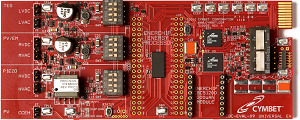 Cymbet Corp. won a gold award in the Sensor Components category for its EnerChip Energy Processor Model CBC915-ACA. The device mediates energy management between the energy harvesting technology (and it is method-agnostic when it comes to the energy harvesting transducer used), energy storage, and the low-power wireless device being powered. The Maximum Peak Power Tracking algorithm constantly matches the energy harvesting transducer's input impedance to achieve the most efficient conversion of ambient energy to useful power. The judges liked the fact that it works with multiple energy-harvesting sources and provides energy management, a vital requirement to make applications powered using ambient energy successful. Says Ramsden, "Power management is the missing link when realizing worthwhile energy harvesting."
Cymbet Corp. won a gold award in the Sensor Components category for its EnerChip Energy Processor Model CBC915-ACA. The device mediates energy management between the energy harvesting technology (and it is method-agnostic when it comes to the energy harvesting transducer used), energy storage, and the low-power wireless device being powered. The Maximum Peak Power Tracking algorithm constantly matches the energy harvesting transducer's input impedance to achieve the most efficient conversion of ambient energy to useful power. The judges liked the fact that it works with multiple energy-harvesting sources and provides energy management, a vital requirement to make applications powered using ambient energy successful. Says Ramsden, "Power management is the missing link when realizing worthwhile energy harvesting."
 Diversified Technical Systems (DTS) Inc. won a gold award in the Data Acquisition Products category for its TSR 65 by 65 by 18 mm shock recorder that can withstand 2000 g of shock, samples at up to 20,000 sps/channel, collects up to 1 GB of data to internal flash memory, and can operate for up to 24 months on an internal battery. Another example of the company's ridiculously robust, compact, and capable DA systems, the TSR stays in ready mode until an event trigger wakes it up, at which point it collects data; when this is done it then automatically re-arms and returns to ready mode. Remember how we look for real-world applications? This little beauty started life as a project with the U.S. Army to create a data recorder that could be embedded into combat helmets to allow the military to detect whether or not the wearer had suffered a traumatic brain injury. Now, it's an off-the-shelf product with a variety of interesting applications.
Diversified Technical Systems (DTS) Inc. won a gold award in the Data Acquisition Products category for its TSR 65 by 65 by 18 mm shock recorder that can withstand 2000 g of shock, samples at up to 20,000 sps/channel, collects up to 1 GB of data to internal flash memory, and can operate for up to 24 months on an internal battery. Another example of the company's ridiculously robust, compact, and capable DA systems, the TSR stays in ready mode until an event trigger wakes it up, at which point it collects data; when this is done it then automatically re-arms and returns to ready mode. Remember how we look for real-world applications? This little beauty started life as a project with the U.S. Army to create a data recorder that could be embedded into combat helmets to allow the military to detect whether or not the wearer had suffered a traumatic brain injury. Now, it's an off-the-shelf product with a variety of interesting applications.
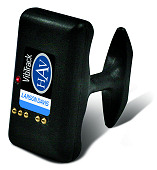 The VibTrack HAV vibration dosimeter from Larson Davis, a divison of PCB Piezotronics Inc. won a gold award in the Sensors category. This small device fits between the fingers and measures the vibration levels that are entering the hand when workers use powered hand tools. Because too much vibration can cause permanent injury, industrial safety professionals have sought to measure vibration exposure levels but were forced to rely on sensors connected by cables to a remote DA device. Because the VibTrack is compact and self-contained, the worker can wear the device throughout a shift while the dosimeter records the levels of vibration to which he or she is exposed. We loved the sheer utility of this device, as it provides an elegant and functional answer to a real need.
The VibTrack HAV vibration dosimeter from Larson Davis, a divison of PCB Piezotronics Inc. won a gold award in the Sensors category. This small device fits between the fingers and measures the vibration levels that are entering the hand when workers use powered hand tools. Because too much vibration can cause permanent injury, industrial safety professionals have sought to measure vibration exposure levels but were forced to rely on sensors connected by cables to a remote DA device. Because the VibTrack is compact and self-contained, the worker can wear the device throughout a shift while the dosimeter records the levels of vibration to which he or she is exposed. We loved the sheer utility of this device, as it provides an elegant and functional answer to a real need.
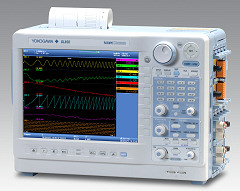 Yokogawa Corp. won a gold award in the Data Acquisition Products category for its DL850 ScopeCorder, which packs oscilloscope and data recorder functionality, along with signal conditioning, high channel counts (up to 128 channels), and the ability to record up to 2 billion data points at speeds up to 100 Msps, into a single unit. The modular architecture allows you to mix and match between the fifteen module types to handle a variety of inputs. Designed to provide both transient and long-term data recording and analysis, and able to zoom in on a signal even during acquisition, it is suited for use in a wide variety of electromechanical measurement applications. That combination of useful and flexible functionality was enough to make Ramsden say, "I want one for Christmas!"
Yokogawa Corp. won a gold award in the Data Acquisition Products category for its DL850 ScopeCorder, which packs oscilloscope and data recorder functionality, along with signal conditioning, high channel counts (up to 128 channels), and the ability to record up to 2 billion data points at speeds up to 100 Msps, into a single unit. The modular architecture allows you to mix and match between the fifteen module types to handle a variety of inputs. Designed to provide both transient and long-term data recording and analysis, and able to zoom in on a signal even during acquisition, it is suited for use in a wide variety of electromechanical measurement applications. That combination of useful and flexible functionality was enough to make Ramsden say, "I want one for Christmas!"
Silver Award Winners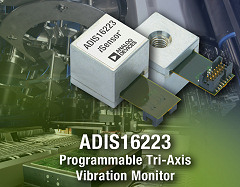 Over the years, Analog Devices Inc. has won a number of Best of Sensors Expo Awards. This year, the company added a silver award in the Sensors category for its ADIS16223 triaxial vibration sensor designed for industrial equipment monitoring. This MEMS digital vibration sensor system incorporates sensing, signal processing, data capture, and a programmable SPI interface. The sensor itself offers ±70 g dynamic range across three axes, a 22 kHz resonance frequency a 72.9 Ksps sample rate, and a flat frequency response from DC to 10 kHz. As noted by Upchurch, "it's a MEMS alternative to the more expensive piezoelectric sensors used for condition and health monitoring. Cost has been a limiter for this application." Because of its size, cost, and capabilities, we felt that this device has the potential to increase the amount of condition monitoring performed for a wider audience.
Over the years, Analog Devices Inc. has won a number of Best of Sensors Expo Awards. This year, the company added a silver award in the Sensors category for its ADIS16223 triaxial vibration sensor designed for industrial equipment monitoring. This MEMS digital vibration sensor system incorporates sensing, signal processing, data capture, and a programmable SPI interface. The sensor itself offers ±70 g dynamic range across three axes, a 22 kHz resonance frequency a 72.9 Ksps sample rate, and a flat frequency response from DC to 10 kHz. As noted by Upchurch, "it's a MEMS alternative to the more expensive piezoelectric sensors used for condition and health monitoring. Cost has been a limiter for this application." Because of its size, cost, and capabilities, we felt that this device has the potential to increase the amount of condition monitoring performed for a wider audience.
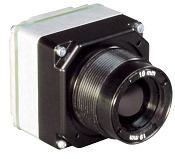 FLIR Systems Inc. won a silver award in the Sensors category for its Tau 640 high-resolution, uncooled thermal camera core. This 2.6 in.3 camera core uses a 17 µm, 640 by 480 pixel uncooled VOx microbolometer focal plane array, operates over the 7.5–13.5 µm spectral band, handles scene temperatures from –40°C to 160°C, and has applications that include unmanned aerial vehicles, thermal sights, unattended sensors, firefighting imagers, and security cameras. The judges were most impressed by its small size and high resolution. Says Martella, "The small size, impressive resolution, and fast speed to image makes this a valuable addition to the thermal imaging toolbox."
FLIR Systems Inc. won a silver award in the Sensors category for its Tau 640 high-resolution, uncooled thermal camera core. This 2.6 in.3 camera core uses a 17 µm, 640 by 480 pixel uncooled VOx microbolometer focal plane array, operates over the 7.5–13.5 µm spectral band, handles scene temperatures from –40°C to 160°C, and has applications that include unmanned aerial vehicles, thermal sights, unattended sensors, firefighting imagers, and security cameras. The judges were most impressed by its small size and high resolution. Says Martella, "The small size, impressive resolution, and fast speed to image makes this a valuable addition to the thermal imaging toolbox."
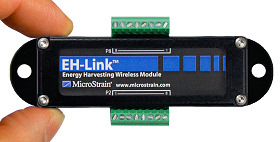 MicroStrain Inc. continues its winning streak by adding a silver award in the Sensors category for its EH-Link Model 6320-0000 hybrid energy harvesting wireless sensor node. While wireless sensor nodes are fairly common, what sets this particular device apart is its combination of onboard sensing (triaxial accelerometer, RH sensor, temperature sensor, and signal conditioning for Wheatstone-bridge-based devices) coupled with the ability to use multiple different types of energy harvesting to power the node. The EH-Link is compatible with piezoelectric, electrodynamic, solar, RF field, and thermoelectric energy harvesters. As Ramsden notes, "This is impressive integration and packaging of energy harvesting, wireless communications, and signal conditioning." Adds Martella, "The ability to use multiple energy harvesting sources simultaneously also provides the capacity for the wireless node to be more deeply embedded."
MicroStrain Inc. continues its winning streak by adding a silver award in the Sensors category for its EH-Link Model 6320-0000 hybrid energy harvesting wireless sensor node. While wireless sensor nodes are fairly common, what sets this particular device apart is its combination of onboard sensing (triaxial accelerometer, RH sensor, temperature sensor, and signal conditioning for Wheatstone-bridge-based devices) coupled with the ability to use multiple different types of energy harvesting to power the node. The EH-Link is compatible with piezoelectric, electrodynamic, solar, RF field, and thermoelectric energy harvesters. As Ramsden notes, "This is impressive integration and packaging of energy harvesting, wireless communications, and signal conditioning." Adds Martella, "The ability to use multiple energy harvesting sources simultaneously also provides the capacity for the wireless node to be more deeply embedded."
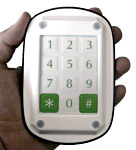 Bronze Award Winners
Bronze Award Winners
Arveni won a bronze award in the Technologies category for its ARxx Series Microgenerator mechanical energy harvester. The device converts actions such as the push of a button into usable electrical energy with an energy conversion efficiency of 20%–35%. The energy harvester is piezoelectric, producing from 0.1–2 mJ. This particular technology has actually been implemented in a TV remote control for a French IPTV provider. The judges thought that this was an interesting and useful addition to the types of available energy harvesting.
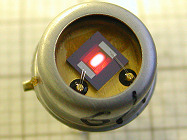 Intex Inc. received a bronze award in the Sensor Components category for its INT20-100 high-power pulsable IR source, distributed in the U.S. by Electro Optical Components Inc. Designed for NDIR gas analysis applications, the source works with pyroelectric, thermopile, and lead selenide detectors and provides 40% more optical power for a 10% increase in input power. Its ability to be pulsed up to 100 Hz and 20 Hz boosts the power to the detector and increases the detector's responsivity. The judges liked the fact that the source's clever architecture enables higher responsivity gas analysis systems without requiring a large increase in the power required for operation.
Intex Inc. received a bronze award in the Sensor Components category for its INT20-100 high-power pulsable IR source, distributed in the U.S. by Electro Optical Components Inc. Designed for NDIR gas analysis applications, the source works with pyroelectric, thermopile, and lead selenide detectors and provides 40% more optical power for a 10% increase in input power. Its ability to be pulsed up to 100 Hz and 20 Hz boosts the power to the detector and increases the detector's responsivity. The judges liked the fact that the source's clever architecture enables higher responsivity gas analysis systems without requiring a large increase in the power required for operation.
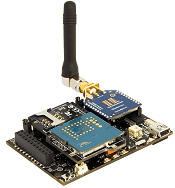 And, finally, Libelium took home a bronze award in the Data Acquisition Products category for its Waspmote modular wireless sensor networking platform. Waspmote offers not only impressive specifications—transmission ranges to 40 km, 0.7 µA current draw in hibernate mode, operation for up to 3 years without recharging the battery, and 802.15.4/ZigBee, 858 MHz, or 900 MHz operation—but couples them with open source software as well as specialized sensor boards for particular applications. The Gas Sensor Board and its built-in carbon monoxide and carbon dioxide sensors, for instance, can be used to detect forest fires, while the Events Sensor Board and its integrated liquid level sensors can be used to warn of river flooding. The judges loved the modular nature of the platform, its use of open source software, and its ruggedness, so important for environmental monitoring applications of all kinds.
And, finally, Libelium took home a bronze award in the Data Acquisition Products category for its Waspmote modular wireless sensor networking platform. Waspmote offers not only impressive specifications—transmission ranges to 40 km, 0.7 µA current draw in hibernate mode, operation for up to 3 years without recharging the battery, and 802.15.4/ZigBee, 858 MHz, or 900 MHz operation—but couples them with open source software as well as specialized sensor boards for particular applications. The Gas Sensor Board and its built-in carbon monoxide and carbon dioxide sensors, for instance, can be used to detect forest fires, while the Events Sensor Board and its integrated liquid level sensors can be used to warn of river flooding. The judges loved the modular nature of the platform, its use of open source software, and its ruggedness, so important for environmental monitoring applications of all kinds.
 Honorable Mentions
Honorable Mentions The first of this year's honorable mention awards goes to Micro-Hybrid GmbH for its PSx200X high-temperature pyroelectric detector, offered in high-temperature packaging with support electronics for use to 180°C, enabling NDIR gas detection systems capable of higher-temperature operation. Our second honorable mention goes to Perpetuum Ltd. for its PMG Free-Standing Harvester. This latest generation of the company's award-winning electromagnetic vibration energy harvester outputs a high-power load-independent DC current up to 4 mA (based on source vibration) and the output current supplied is consistent, whether measured during installation or charging a storage capacitor up to 5 V. The judges loved the improvements and demonstrated utility of the device.
The first of this year's honorable mention awards goes to Micro-Hybrid GmbH for its PSx200X high-temperature pyroelectric detector, offered in high-temperature packaging with support electronics for use to 180°C, enabling NDIR gas detection systems capable of higher-temperature operation. Our second honorable mention goes to Perpetuum Ltd. for its PMG Free-Standing Harvester. This latest generation of the company's award-winning electromagnetic vibration energy harvester outputs a high-power load-independent DC current up to 4 mA (based on source vibration) and the output current supplied is consistent, whether measured during installation or charging a storage capacitor up to 5 V. The judges loved the improvements and demonstrated utility of the device.
Congratulations again to all this year's award winners and I can't wait to see what's in the running for the 2011 Best of Sensors Expo Awards!
ABOUT THE AUTHOR
Melanie Martella is Executive Editor of Sensors magazine. She can be reached at [email protected].
